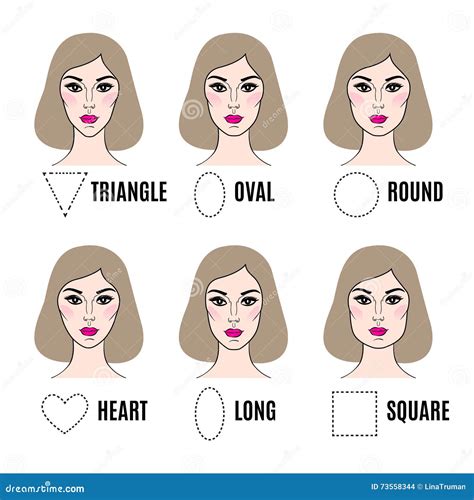Identifying Your Face Shape
Understanding your face shape is crucial when choosing a flattering hairstyle. Here’s a breakdown of common face shapes and their key features:

- Oval: Well-balanced and symmetrical, with equal width at the forehead and jawline.
- Round: Soft and curved, with no sharp angles. Full cheeks and a rounded chin.
- Square: Strong jawline and a broad forehead of similar width.
- Heart: Narrow chin, wide forehead, and a widow’s peak.
- Diamond: Narrow forehead and chin, with wide cheekbones.
- Oblong: Long and narrow, with a high forehead and a narrow jawline.
- Triangle: Narrow forehead and wide jawline.
Hairstyles for Each Face Shape
Oval Face Shape:
- Any hairstyle suits an oval face, as it’s considered the most versatile shape.
- Long, layered hair adds volume and balance.
- Pixie cuts emphasize the facial features.
Round Face Shape:
- Hairstyles that elongate the face are recommended.
- Long, straight hair with side bangs creates a slimming effect.
- Short, layered hair with volume at the crown adds height.
Square Face Shape:
- Hairstyles that soften the angles are ideal.
- Long, wavy hair with side-swept bangs frames the face.
- Bobs with soft layers add movement and reduce angularity.
Heart Face Shape:
- Hairstyles that balance the wide forehead are recommended.
- Long, layered hair with bangs at the widest part of the forehead.
- Pixie cuts with short, side-swept bangs that follow the hairline.
Diamond Face Shape:
- Hairstyles that highlight the cheekbones are flattering.
- Long, layered hair with a deep side part.
- Short, angled bobs with bangs that frame the face.
Oblong Face Shape:
- Hairstyles that add width to the face are recommended.
- Bangs that extend past the eyebrows create a shorter illusion.
- Layered haircuts with lots of volume at the cheekbones.
Triangle Face Shape:
- Hairstyles that balance the narrow chin are flattering.
- Long, straight hair with layers at the chin creates fullness.
- Bobs with blunt bangs that reach the cheekbones.
Common Mistakes to Avoid
- Choosing the wrong hairstyle for your face shape: This can emphasize undesirable features and make your face appear unbalanced.
- Overstyling: Too much product or heat can damage your hair and make it look unnatural.
- Not considering your hair texture and density: Some hairstyles are not suitable for all hair types. Thin hair may appear limp in certain styles, while thick hair can overwhelm delicate features.
- Neglecting your hair’s health: Healthy hair is essential for any hairstyle. Regular trims, conditioning, and proper styling techniques can maintain the integrity of your locks.
Benefits of Choosing the Right Hairstyle
- Enhances your natural beauty: A well-chosen hairstyle can accentuate your best features and make you feel more confident.
- Completes your overall look: Your hairstyle plays a significant role in creating a cohesive and stylish aesthetic.
- Improves your mood: Studies have shown that a new hairstyle can boost self-esteem and improve overall mood.
- Saves time and effort: A hairstyle that suits your face shape and is easy to maintain will save you time and effort in the long run.
How to Choose the Right Hairstyle
- Determine your face shape: Use the guidelines outlined above to identify your face shape.
- Research hairstyles: Browse magazines, online hair catalogs, and consult with a hairstylist to find hairstyles that complement your face shape.
- Consider your hair texture and density: Choose hairstyles that are suitable for your hair type.
- Personalize your style: Don’t be afraid to experiment with different styles and variations within your face shape recommendations.
- Consult with a hairstylist: A professional hairstylist can provide expert advice and guidance based on your individual needs.
Conclusion
Choosing the right hairstyle for your face shape is an essential aspect of enhancing your appearance and boosting your confidence. By understanding the different face shapes and the hairstyles that best suit them, you can create a look that complements your natural features and makes you feel your best. Remember to consider your hair texture and density, avoid common mistakes, and consult with a hairstylist for personalized guidance.
